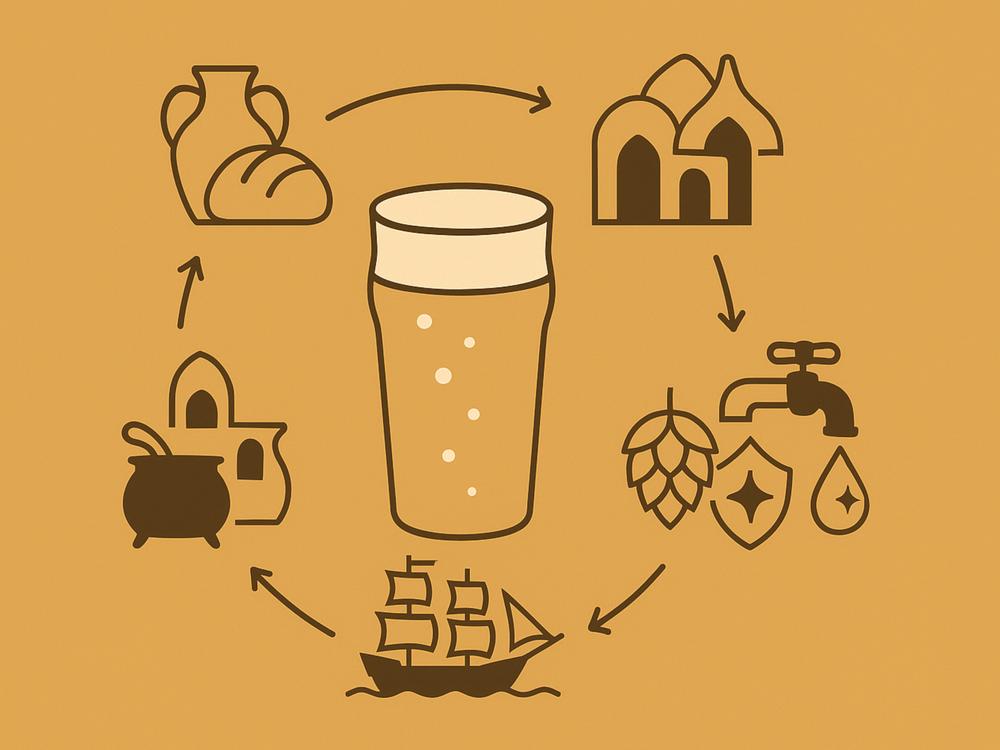A Short History of Beer
Published August 19, 2025
Contents
- 1) Ancient beginnings: bread you can drink
- 2) Medieval towns: household pots to monastic breweries
- 3) Early modern cities: scale, storage, and the brewer’s advantage
- 4) IPA’s moment: making beer travel
- 5) Pipes, filters, chlorine: the end of the old rule
- What this history means (for beer people and whisky folk)
- Pocket timeline
- Bottom line

Before copper stills and dunnage warehouses, there was hot mash and cool fermentation. For much of urban history, beer wasn’t just a treat; it was infrastructure-a reliable daily drink when town water could be suspect. This is a historical sketch of how that came to be, and how IPA later extended beer’s keeping power for long journeys.
1) Ancient beginnings: bread you can drink
In the grain cultures of Mesopotamia and Egypt, beer sat on the bread-beer continuum. Cereal mashes were heated, fermented, and consumed fresh. The important bit for safety wasn’t a theory of germs (no one had that yet)-it was process:
- Heat: Mashes were brought to the boil or near it during brewing.
- Acid & alcohol: Fermentation dropped pH and added a little ethanol.
- Freshness: Everyday beers were low in strength and consumed quickly.
The result was a stable, hydrating staple that travelled better than raw water in clay vessels and doubled as calories for workers (see also the “drunken monkey” hypothesis). Beer appears in rations, wages, and ritual-proof of its central, practical role.
2) Medieval towns: household pots to monastic breweries
As European towns thickened, so did the risks of foul wells and surface water. Brewing scaled from alewives and household kettles to monasteries and urban brewhouses:
- Boiling the wort acted like a crude water treatment step (then cooling-think early heat exchangers like the Morton refrigerator).
- Fermentation added mild alcohol and acidity that discouraged spoilage.
- Service strength: “Small beer” (often ~1-3% ABV) was brewed for daily table use.
By the 12th-15th centuries, hops spread across northern Europe, displacing gruit mixtures. Hops contributed bitterness and shelf life: their iso-α-acids are naturally antimicrobial, especially against Gram-positive bacteria. In crowded towns without sewers, beer became the dependable daily drink.
3) Early modern cities: scale, storage, and the brewer’s advantage
From the 16th to 18th centuries, urbanisation and trade expanded the brewery’s footprint:
- Bigger kit, cleaner practice: Professional breweries standardised boiling, cooling, and yeast management.
- Styles built for keeping: Porter in 18th-century London thrived in large vats; lager techniques elsewhere exploited cool storage (again, early tech like the Morton refrigerator).
- Public health by accident: No one was “disinfecting” water on purpose, yet the brew cycle consistently produced a beverage less prone to harbour pathogens than many raw urban supplies.
“Beer is safer than water” was less a slogan than a lived habit: in workshops, at the table, and on the road, small beer and table ales hydrated the workday (for historical context, see Barnard’s Victorian surveys).
4) IPA’s moment: making beer travel
India Pale Ale belongs to the age of sail and empire, when beer needed to survive months at sea and tropical holds:
- More hops, longer life: Heavy hopping helped beer endure heat and motion, arriving bright and bitter.
- Drier, stronger base: Lean, well-attenuated worts (traditionally a touch stronger than table beers) left fewer sugars for spoilage.
- Water chemistry: Burton-upon-Trent’s sulfate-rich water accentuated hop crispness and stability (the role of water & whisky water).
IPA wasn’t invented because all water was dangerous; it was engineered so beer could travel and keep. In ports and garrisons where water quality was iffy, a well-kept cask was a sensible option.
5) Pipes, filters, chlorine: the end of the old rule
The 19th and 20th centuries brought sewers, sand filtration (technical note), and chlorination. Municipal networks made tap water in regulated cities far safer than any historic supply. From then on, beer’s role as default hydration waned. People still drank beer, of course-but for taste, culture, and calories, not because it was the only reliable option.
What this history means (for beer people and whisky folk)
Beer’s long run as the “safer sip” was built on heat, controlled fermentation, and mild acidity-the same levers distillers lean on before spirit ever meets oak. Clean mash tuns, healthy yeast, and sensible pH are the foundations of flavour whether you’re racking ale or charging a wash still (esters; oxidation & preventing oxidisation). If you want to connect the dots to the glass, see whisky production basics, and how choices later on-bottling ABV or cask strength-shape texture and stability.
Pocket timeline
- Mesopotamia & Egypt: Bread-beer staples; hot mashes, fast turnover.
- Medieval Europe: Small beer for daily hydration; monasteries and town brewers refine the craft; hops spread.
- Early modern cities: Professional breweries scale; porter and lager show the value of storage and cleanliness (Morton refrigerator).
- 18th-19th centuries: IPA emerges for export; hops + attenuation + water chemistry = durability.
- Modern era: Sewers, filtration, chlorination-tap water overtakes beer for safety in regulated systems.
Bottom line
For much of urban history, the brewery functioned as a practical water-treatment plant. Boiling, fermentation, acidity, and hops made beer a reliable everyday drink where raw supplies were risky. IPA extended that reliability across oceans. Today, with modern sanitation, we drink beer because we love it, not because we need it-and that makes the old story a piece of history rather than a rule to live by.

